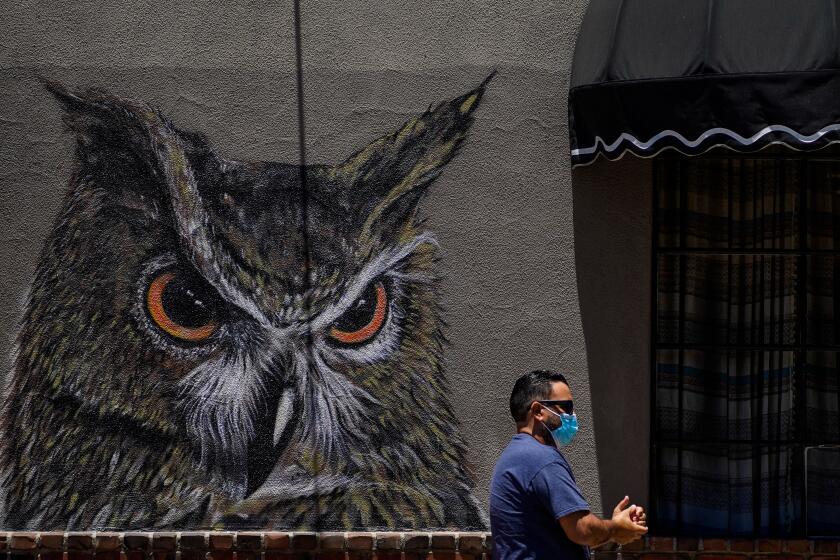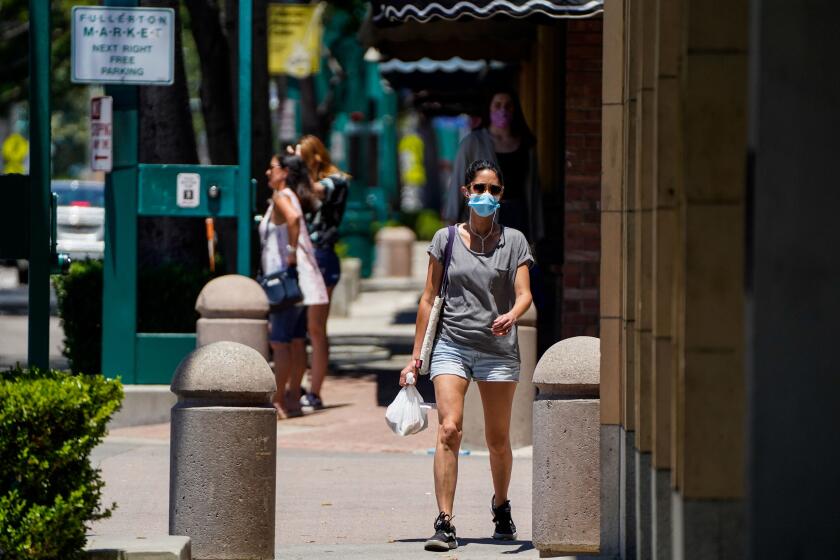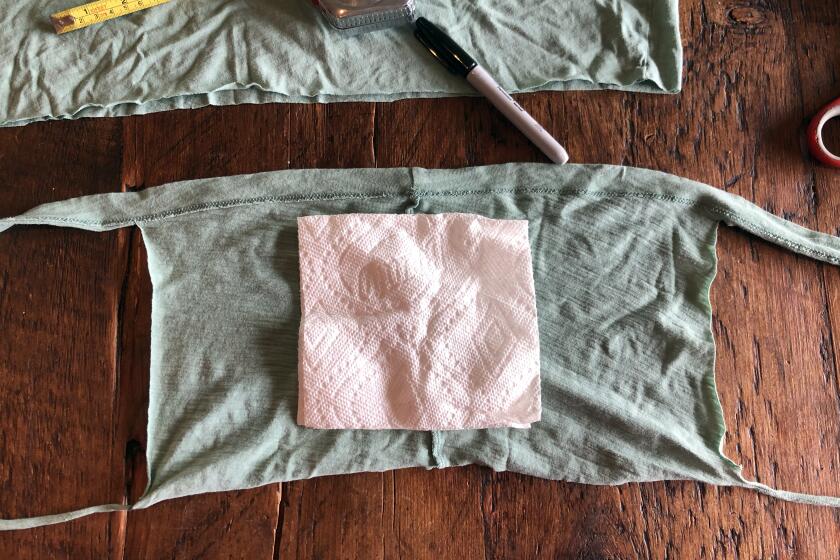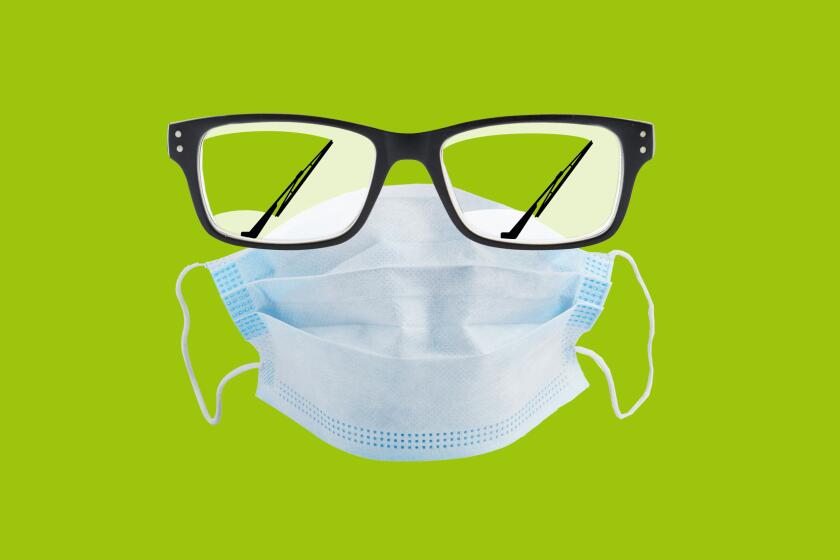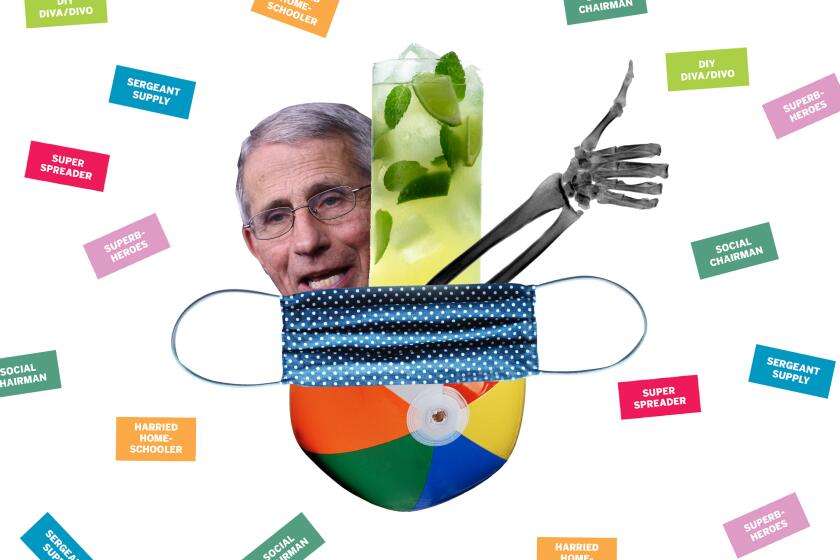Mask shaming men won’t work. Here’s what will
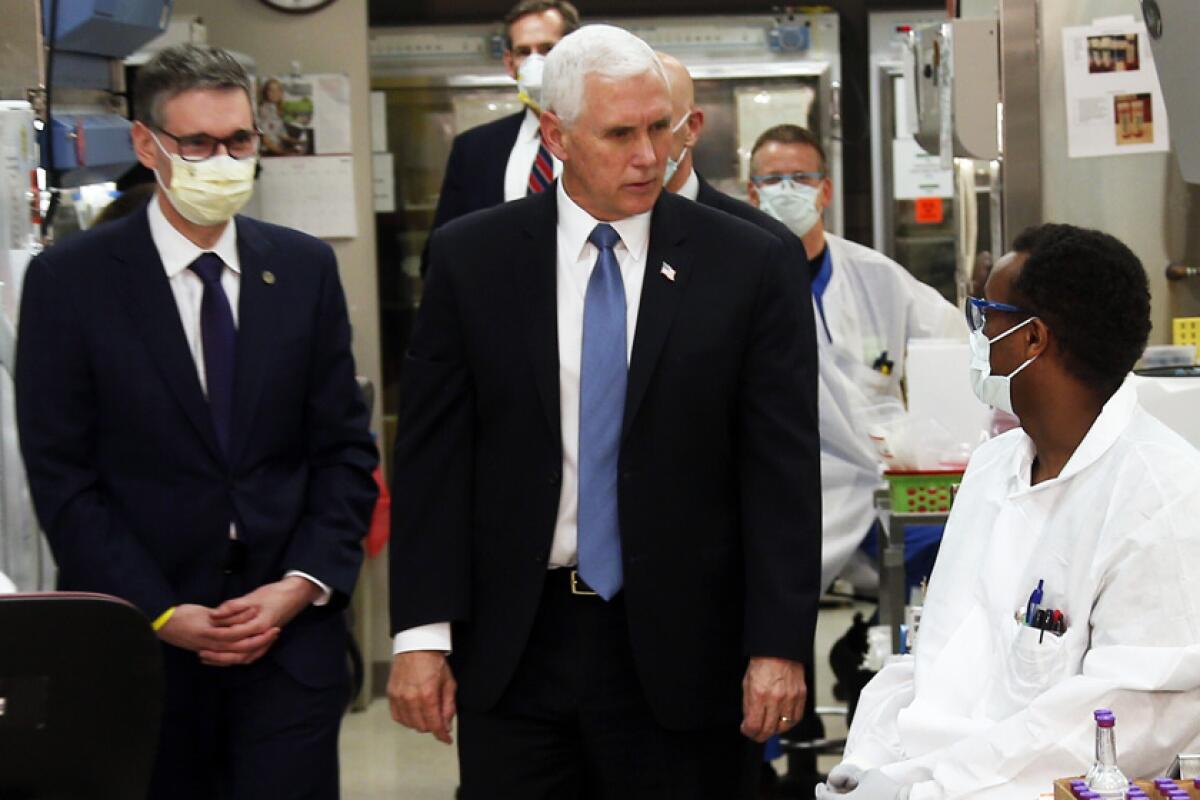
- Share via
Darth Vader, the Minnesota Vikings and Mike Pence, who’s wearing a “Make America Great Again” face mask, walk into a bar.
That may sound like the setup to a very funny (and perhaps risqué) joke, but it also hints at how to solve a deadly serious problem: getting more people — particularly the swaggeringly toxic mask-averse males of the species — to don face coverings in public to help prevent the spread of the coronavirus.
Although there’s certainly no shortage of antimask women out there (including a few in my own family tree), we’re focusing specifically on men here for two reasons. First, men are statistically more adversely affected by COVID-19 than women.
Second, a recently released study authored by researchers Valerio Capraro of London’s Middlesex University and Hélène Barcelo of the Mathematical Sciences Research Institute in Berkeley found that men are less likely than women to wear face coverings.
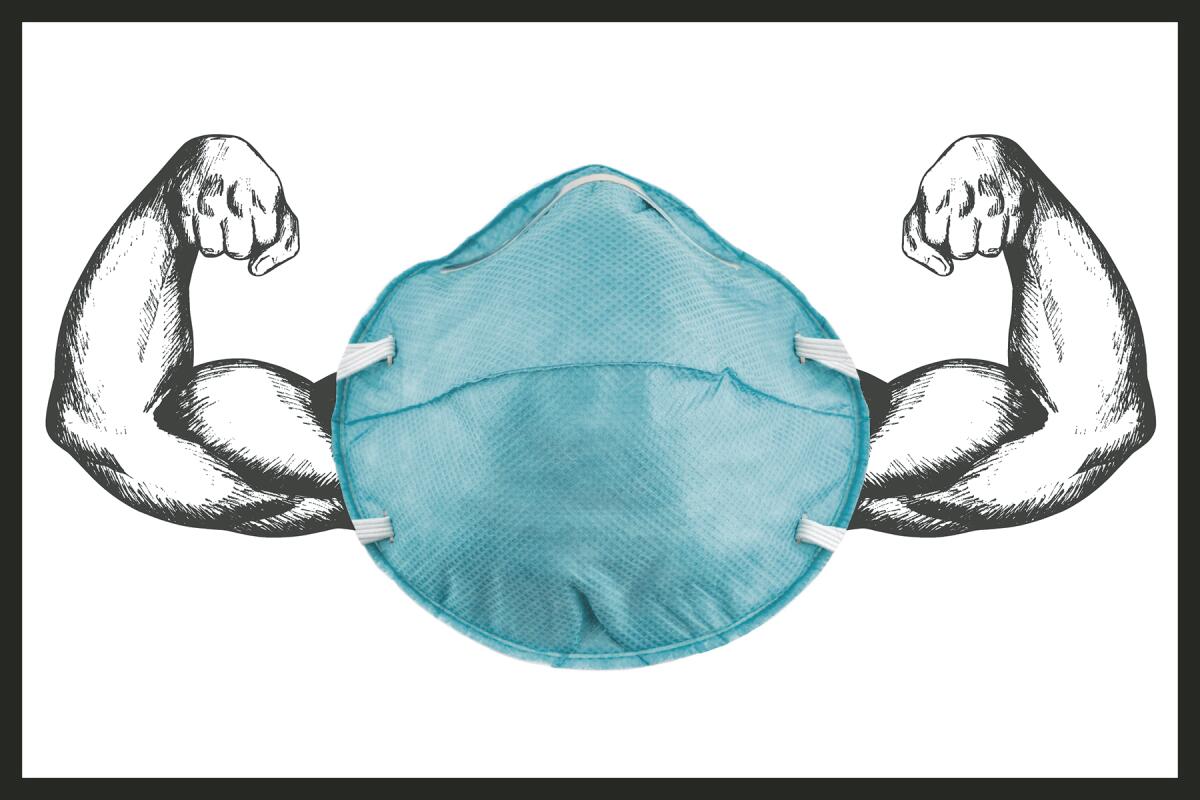
That probably doesn’t come as much of a surprise to anyone who has watched the president of the United States and his No. 2, the latter of whom happens to be the chair of the White House Coronavirus Task Force, fly in the face of science by not covering their own faces in public. Or maybe your lack of surprise comes from the curious sight of a family unit who has caught your eye: The mother and children are dutifully mask-clad out in public but, for some reason, the father is not.
It was the latter scenario happening on a Berkeley street that inspired mathematician Barcelo to crunch the numbers on gender differences and mask-wearing, she explained to The Times.
In California, mandatory face coverings that experts say reduce the spread of the coronavirus are at the center of an intense political fight.
“They were outside on bicycles — a papa, a mama and two kids,” Barcelo said. “And the mama and the two kids were wearing masks. And the papa had a mask, but it was around his neck, not on his face. I thought, ‘OK, maybe there is something there,’ and Valerio and I decided to look into it more carefully.”
Posted online in mid-May, the resulting study of 2,459 U.S. participants, “The Effect of Messaging and Gender on Intentions to Wear a Face Covering to Slow Down COVID-19 Transmission,” offers an interesting glimpse into why some men resist the call to cover up — and provides some clues as to how to influence that behavior. In addition to finding that men are less inclined to wear a face mask, the study found that men are less likely than women to believe they will be seriously affected by the coronavirus.
Further, it found a big difference between men and women when it came to the self-reported negative emotions that come with that simple strip of fabric across the face.
As study co-author Capraro explained, “We asked [participants to rank] on a scale of one to 10 how much they agreed with five different statements: ‘Wearing a face covering is cool,’ ‘Wearing a face covering is not cool,’ ‘Wearing a face covering is shameful,’ ‘Wearing a face covering is a sign of weakness’ and ‘The stigma attached to wearing a face covering is preventing me from wearing one as often as I should.’
“The two statements that showed the biggest difference between men and women,” Capraro said, “were, ‘Wearing a face covering is a sign of weakness’ and ‘The stigma attached to wearing a face covering is preventing me from wearing one as often as I should.’”
Armed with this sort of insight, might it be possible to hack the male mind to motivate more men to wear a face covering in public? To answer that question, we sought the input of folks who’ve studied the topic, including the study’s authors, a couple of psychologists who focus on men’s behavior and a medical historian. Together, their suggestions make up a broad, four-pronged strategy we’re going to call the M.A.S.K. Approach.M — Make it about the community, not the individual
A big part of Capraro and Barcelo’s study focused on trying to figure out what sort of messaging would be most effective in convincing mask-averse folks (male and female) to wear one. It found that emphasizing the benefit to one’s community rather than one’s family, one’s country or one’s self was the biggest motivator.
However, they note, and it bears repeating here, the biggest motivator of all is a mandatory mask order. In that instance, the authors write, the gender difference on the intention to wear a mask “almost disappears.”
The new health order marks a major shift in many parts of California, where most counties — including Orange, Riverside and San Bernardino — do not have mask requirements.
Peter Glick, a professor at Lawrence University in Appleton, Wis., whose work focuses on understanding and overcoming biases and stereotyping, agrees that reframing the decision to wear a mask to be about community, not self, might have merit. “One of my areas of research is in benevolent sexism . So one way to rebrand this is instead of [making it about] protecting yourself, make it about protecting other people. [Make it about being] paternalistic and chivalrous. You’re saying, ‘I’m protecting the weak, the elderly; I’m being a hero.”A — Appeal to patriotism
If mask-hating men won’t wear face coverings for the health and safety of the fragile flower on her fainting couch or for the old and infirm, perhaps they’ll do it for God and country.
According to Alex Navarro, assistant director of the Center for the History of Medicine at the University of Michigan and one of the editors-in-chief of the American Influenza Epidemic of 1918-1919: A Digital Encyclopedia, an overt appeal to patriotism was used to encourage mask wearing in the early stages of the Spanish flu epidemic as the country was still fighting World War I.
He also said that although the first mandatory mask orders were met with opposition, they also were bolstered by what he described as a surge in patriotic messaging —
public service announcements by the Red Cross and other groups that urged people to “do their part” and chided the noncompliant as “slackers.”
In a pinch, a T-shirt can be used to create a no-sew mask to help slow the spread of the coronavirus.
Navarro said that although there is no historical data to show how effective the appeal to patriotism was, there was plenty of press coverage chronicling the opposition to masks later in 1919, when the war was over and San Francisco saw the formation of an antimask league. Might an appeal to patriotism affect mask donning in the current pandemic? After a note of caution about predicting the future based on the past (“Historians are always a little bit leery about that,” he said), Navarro suggests it could.
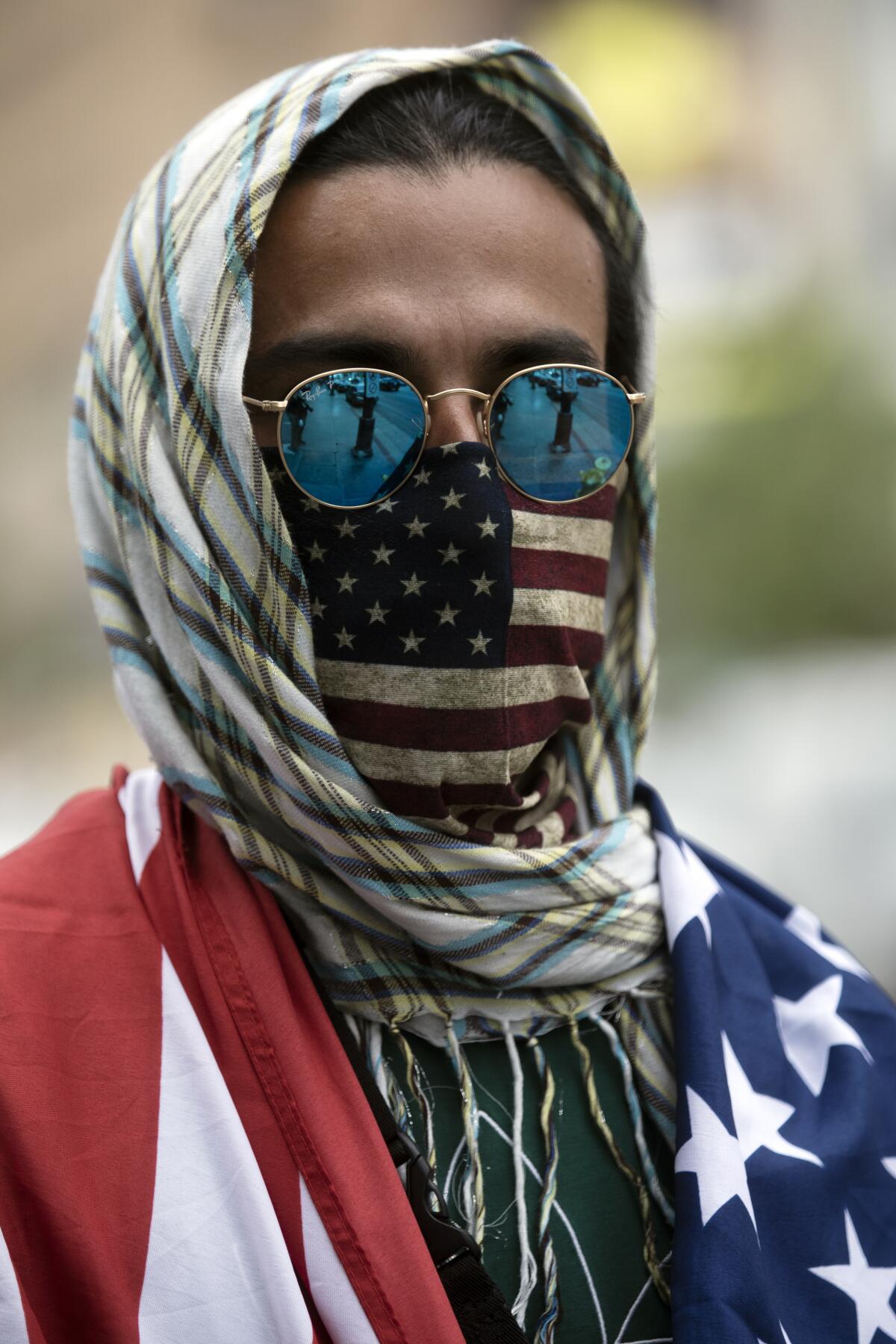
“If not necessarily in a direct appeal to patriotism like we saw in 1918,” he said, “I think certainly in an appeal to do the right thing for America by [emphasizing] getting back to a normal economy. The message is, ‘We cannot have a normal economy until we get the pandemic under control,’ and that is not going to happen 100% until we get a vaccine. But we can get much closer to having it under control if people comply with social distancing and wearing a mask while in public.”S — Stick with the stereotypes
If stereotypical masculine behavior is part of the problem, might it be part of the solution? Could some of the traits traditionally associated with manliness be Trojan Horsed to increase the number of masked men? Glick, who back in April penned a piece for Scientific American titled “Masks and Emasculation: Why Some Men Refuse to Take Safety Precautions,” thinks the approach might work.
“Of course you’d be playing into this kind of masculinity,” Glick said, “but I think tough-looking masks — MAGA masks, camouflage[-print masks], [masks printed with] shark teeth — might. They wear masks in wrestling, right? And what about superheroes and villains?
Study authors Capraro and Barcelo muse that sports-team-affiliated face masks might be worth a try. “We didn’t study this so we can’t say for sure,” Capraro said. “But I agree [with Hélène] that masks that identify people with something — for example, a sport team — might [persuade more men to wear face coverings], especially because we know from other research that men compared to women have a stronger tendency to identify with a team.”
Wearing masks will help minimize the spread of COVID-19. Here’s how to do it right.
Before you scoff at the notion of truculent menfolk falling for such a simple and transparent ploy, typing the words “manly mask” at the Etsy website reveals a treasure trove of options that practically ooze testosterone: masks in lumberjack plaids and bandanna patterns, or adorned with tractors, cigars, whiskey bottles, trout, handlebar mustaches and the Minnesota Vikings’ team logo for starters.
There is some precedent in tapping into masculine stereotypes to influence health behavior, according to Matt Englar-Carlson, author of several books on masculinity and director of Cal State Fullerton’s Center for Boys and Men. He pointed to a 2003-05 NIMH campaign called “Real Men. Real Depression.” “They created a bunch of PSAs [featuring] tough men,” Englar-Carlson said, “a retired Air Force guy, a guy in law enforcement, a firefighter, who would talk, essentially, talk about being tough and also having depression. So people in public health have actually tried to do things like this.”K — Key into humor
While the coronavirus pandemic is certainly no laughing matter, Englar-Carlson thinks getting more guys to wear face coverings might be.
“I think [humor] definitely could work,” he said. “A lot of men communicate this way. They have serious conversations but in humorous ways because [they] can’t fully own it, so [they] joke about it. For example, guys in the locker room might be talking about the difficulties in [their] marriages but by joking about it. It’s kind of a code they use to communicate, to admit they’re having a hard time.”
Englar-Carlson said he wasn’t sure what a humorous messaging campaign around mask-wearing might look like, but with Glick’s comment about wrestlers, superheroes and villains echoing in my ears, I floated one possibility: a PSA featuring Darth Vader, Bane from “The Dark Knight Rises” and a cadre of Lucha Libre wrestlers playing it tough while urging guys to put on their own masks.
“Like a ‘real men wear masks’ thing, right?” Englar-Carlson said. “That could be a way into it, even though the ‘real men’ thing is something that I really hate.”
Are you a Super Spreader or a Superb Hero? Revealing your secret identity is just a few steps away.
Until there’s a sweeping nationwide campaign, humorous or otherwise, aimed at getting more men to wear face coverings in public, it’s up to every individual, business and local government entity to use all four prongs of the M.A.S.K. Approach to convince mask-averse men to do the right thing. That Independence Day bash you’re hosting, for example? That could be a good opportunity to put out a stack of star-spangled face coverings. (After all, who can say no to Old Glory on the Fourth of July?)
Even if deployed skillfully and surreptitiously, none of these man-brain hacks will be totally effective. As mentioned, the most effective way to increase mask-wearing (for both genders) is to simply make the order mandatory. That’s what California Gov. Gavin Newsom did Thursday in response to a spike in COVID-19 cases. However, as the University of Michigan’s Navarro points out, getting every last man, woman and child to wear a mask is not really the goal.
“Whether it’s through vaccination, [PSA] campaigns or social distancing measures, you’re never going to get a 100% compliance. You try and get as high as you can,” he said. “We now know from a lot of modeling studies and studies involving masks that if we can get over 50% — preferably 60% to 80% of compliance with mask orders — we could really drive this epidemic to a manageable level between now and the time we get a vaccine.”
Get The Wild newsletter.
The essential weekly guide to enjoying the outdoors in Southern California. Insider tips on the best of our beaches, trails, parks, deserts, forests and mountains.
You may occasionally receive promotional content from the Los Angeles Times.
More to Read
Sign up for The Wild
We’ll help you find the best places to hike, bike and run, as well as the perfect silent spots for meditation and yoga.
You may occasionally receive promotional content from the Los Angeles Times.

